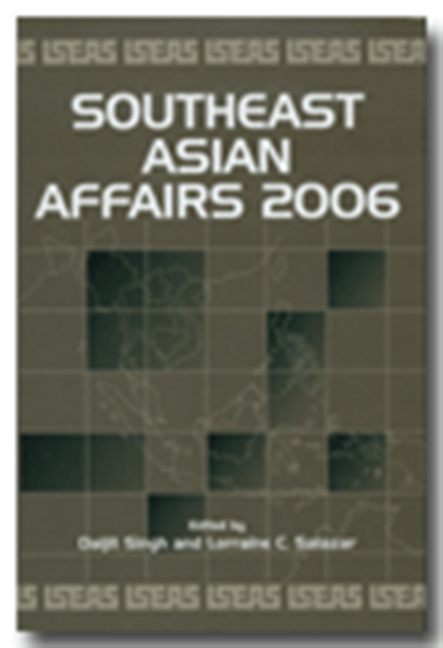Book contents
- Frontmatter
- Contents
- Foreword
- Introduction
- The Region
- Southeast Asia in 2005: Strength in the Face of Adversity
- Southeast Asian Economies: A Year of Exogenous Shocks
- Terrorism: Evolving Regional Alliances and State Failure in Mindanao
- Japan in an Insecure East Asia: Redefining Its Role in East Asian Community-Building
- Brunei darussalam
- Cambodia
- Indonesia
- Laos
- Malaysia
- Myanmar
- The Philippines
- Singapore
- Thailand
- Timor Leste
- Vietnam
Japan in an Insecure East Asia: Redefining Its Role in East Asian Community-Building
from The Region
Published online by Cambridge University Press: 21 October 2015
- Frontmatter
- Contents
- Foreword
- Introduction
- The Region
- Southeast Asia in 2005: Strength in the Face of Adversity
- Southeast Asian Economies: A Year of Exogenous Shocks
- Terrorism: Evolving Regional Alliances and State Failure in Mindanao
- Japan in an Insecure East Asia: Redefining Its Role in East Asian Community-Building
- Brunei darussalam
- Cambodia
- Indonesia
- Laos
- Malaysia
- Myanmar
- The Philippines
- Singapore
- Thailand
- Timor Leste
- Vietnam
Summary
This article analyses Japan's policy towards East Asia in general and East Asian community-building in particular. Japan, as a global nation, has huge stakes in strengthening global governance institutions such as the United Nations (UN), World Trade Organization (WTO), Non-Proliferation Treaty (NPT), and International Atomic Energy Agency (IAEA). To respond to transnational and global issues such as economic globalization, the spread of weapons of mass destruction (WMD), and international terrorism, Japan needs to enhance global mechanisms and make a substantial contribution to such global governance institutions. Japan's bid for a permanent membership at the UN Security Council and the amendment of the Japanese Constitution that is on the domestic political agenda must be understood in this context.
At the same time, ‘regions’ or regionalisms are becoming a more salient concept for managing politico-security and economic affairs in today's world. We are entering an era of ‘A World of Regions’. 1 East Asia is becoming a more important region for Japan's peace and prosperity. The great transformation of East Asia is posing great challenges and opportunities for Japan, demanding its strong commitment to East Asian community-building.
Growing trade which is linked with foreign direct investments (FDI) and foreign production is integrating the Japanese economy closely with East Asia. Japanese multinational firms have shifted to international production and reorganized their business activities accordingly. Their production networks are spread over a large number of countries. This trend has created a strong Japanese interest in liberalization, guarantees for Japanese investment, and institution-building in order to manage these economic relations.
Essentially two region-wide production and distribution networks have been established by Japanese firms in East Asia since the middle of 1980s, one with Southeast Asia and the other with China. The pressing task for Japan is to connect these two production networks more closely, thereby constructing ‘seamless’ networks of production and distribution in East Asia.
- Type
- Chapter
- Information
- Southeast Asian Affairs 2006 , pp. 39 - 54Publisher: ISEAS–Yusof Ishak InstitutePrint publication year: 2006



